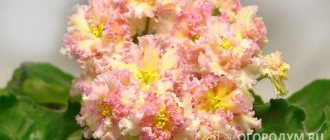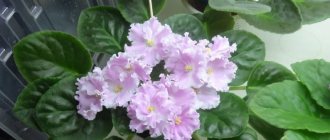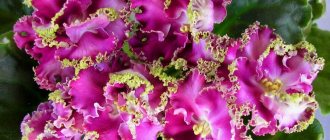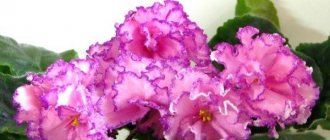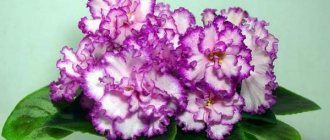Description and characteristics of the variety
Among other Saintpaulias, Zlato Skifov stands out due to its yellow tint, which appears on the petals when properly maintained. But violets do not have the gene responsible for this color.
Yellow corollas can be obtained in two ways:
- through selective selection, when the green is washed out and changes so much that it begins to appear straw or golden;
- using genetic engineering - the method is currently available only to large companies or breeders with special knowledge, materials and equipment.
What does a bush look like?
Violet Zlato Skifov forms a standard size rosette (20-40 cm). Its diameter is closer to the lower limit of the group; even with good maintenance, it almost never reaches 30 cm in cross section.
Zlato Skifov produces slightly elongated, heart-shaped, velvety, medium green leaves. In Spartan conditions, the surface of the violet plates is smooth; with good care, it can be called quilted - the fabrics above the depressed veins rise slightly.
The tip is blunt, the reverse is almost invisible. The edge of the leaves is wavy and, thanks to the large rounded teeth, is classified as scalloped.
Fans complain that it is not easy to grow a beautiful symmetrical rosette.
Description of flowers
The main highlight of the Zlato Skifov variety is the yellow color of the petals. Those expecting a bright shade will be disappointed. It manifests itself weakly and not always. Even to take a good photo, you have to set the lighting correctly and use special techniques.
But the violet is actually spectacular - terry, with fringed petals. The flower is flat, the anthers are clearly visible. The buds are collected in 2-4 pieces.
In the description of the variety it is often stated that the diameter of the corollas reaches 6 cm. In practice, they grow so large only when there are a small number of buds on the violet.
Scythian gold produces bouquet flowering on adult rosettes, usually the diameter of the corollas is 4-5 cm.
The color of the closed buds is white. When opened, they remain monochromatic for 3-4 days, then an uneven pink border appears, lighter towards the center. When the violet is kept cool, sometimes greenery can be seen along the very edge of the petals.
The yellow tint is especially noticeable at the base of the corollas. In the middle of the flower it is blurred, and closer to the edge it disappears.
Similar varieties
Zlato Scythians are sometimes confused with other Saintpaulias. But only if they read the description and don’t look at the photo:
LE Gold of the Scythians
- The Zlata variety from Elena Lebetskaya is really similar, but differs in its purple border.
- AB Scythian Gold, contrary to the claims of online stores and bloggers, is almost impossible to confuse with the violet in question. On one bush there are simple and semi-double flowers. The petals are not fringed, like those of LE Zlato Scythians, but only slightly wavy. A pink border with a carmine tint runs only along the edge, never taking up most of the corolla.
Violet Gold of Scythians from Alexey Valkov seems more yellow. In fact, it is the same, just because it is less terry, the center of the corollas is better visible.
Planting cherry plum
Planting cherry plum Scythian Gold is not difficult even for an inexperienced gardener. They start, as usual, by choosing the place where the future tree will grow. It must meet certain criteria related to the characteristics of the variety:
- At the planting site there should be no close groundwater and no stagnation of water.
- Cherry plum is undemanding to the composition of the soil. But the structure is important - it needs loose and well-drained soils with a neutral or slightly alkaline reaction.
- The cherry plum will bear fruit abundantly only with sufficient sunlight and ventilation, but it does not like drafts.
- The plant is also afraid of cold northern winds.
Due to these features, it is better to plant Scythian Gold on small southern or southwestern slopes. Protection from winds in the form of a building wall, fence or dense trees located to the north or northeast of the planting site is desirable. If this is not possible, you need to initially arrange protection from specially knocked down shields, painted white. The sun's rays reflected from the surface will additionally heat and illuminate the plant. This is especially true for northern latitudes.
The best time to plant seedlings in the ground is early spring, before the buds swell. If seedlings with a closed root system have been selected, then they can be planted at any time from April to October.
Planting cherry plum - step-by-step instructions
The result will depend on how responsibly the gardener approaches the implementation of planting rules and techniques:
Buy a seedling. This is done in the fall, during the period of mass digging of seedlings by nurseries for sale. By the way, it would be better to do this in the nursery. At the market you can get either a variety that is not the one declared by the seller, or even some kind of game. One- or two-year-old seedlings take root better and begin bearing fruit faster—and they should be given preference. When purchasing, inspect the root system - the roots must be healthy, developed, without foreign cones and growths.
The seedling will overwinter buried in the ground. To do this, dig an oblong hole in the garden along the length of the seedling. Its depth should be 30–40 cm. A layer of sand is poured onto the bottom. It is advisable to dip the roots into a clay mash, let it dry a little and place the seedling in the hole. Cover it with a layer of sand, moisten it and fill the hole with earth, leaving only the top of the tree on the surface. If possible, you can store the seedling in the basement at an air temperature of 0 to +5°C.
Then prepare the landing pit. This is done as follows: At the selected location, dig a hole with a diameter of 70–80 cm and the same depth. In this case, the fertile layer of soil is folded separately - it can be used. If the soil is heavy or clayey, arrange drainage to drain excess water. To do this, a ten-centimeter layer of crushed stone, gravel, broken brick, etc. is poured onto the bottom of the pit. The pit is filled to the top with a nutrient mixture - humus, chernozem, peat, sand in equal parts. Add 2–3 liters of wood ash, 300–400 g of superphosphate and mix well with a pitchfork. Cover the pit with a moisture-proof material (film, roofing felt, slate, etc.) to prevent the leaching of nutrients.
When the time comes for planting, take out the seedling and soak it in water for 2–3 hours. You can add Kornevin, Heteroauxin or other root growth stimulants to the water. The planting pit is opened and a small mound is formed in it. Place the seedling with its root collar on the top of the mound, and spread the roots along its slopes.
Fill the hole with earth. This must be done in several steps, compacting the soil each time.
Install the root collar of the seedling at the correct height
It is important to ensure that it ends up at soil level. To do this, you first need to install the root collar a little higher. Then, after watering, the soil will settle, and it will be at the desired height. Make a circle around the diameter of the hole. Water generously - all the soil in the planting hole should be moistened
This ensures good contact between the roots and the ground and removes air bubbles that usually form when filling the hole.
Then, after watering, the soil will settle, and it will be at the desired height. Make a circle around the diameter of the hole. Water generously with water - all the soil in the planting hole should be moistened. This ensures good contact between the roots and the ground and removes air bubbles that usually form when filling the hole.
After the soil dries, it needs to be loosened and mulched. For this you can use hay, humus, compost, etc. Trim the seedling to a height of 60–80 cm. If it has branches, they are shortened by 30–40%.
Flowering period and characteristics
Most varieties of Elena Lebetskaya, including Zlato Skifov, form buds according to the bouquet type - in the center of the bushes, almost simultaneously, regardless of the season. Fans only need to help the plant a little to make the hat especially lush.
But this type of flowering has a downside. The violet is at the peak of its decorativeness for 45-60 days, then it rests for the same amount of time and produces new buds, which also need time to open. With good care there will be 3 waves of flowering per year.
You can force Zlato Scythians to bloom gradually - almost constantly putting forward sparse flower stalks located at an angle to the leaves. But this way the violet will lose most of its attractiveness.
The plates of the cultivar do not fit tightly together, but amateurs often complain that the buds have difficulty making their way to the light. Usually the situation is resolved in one of the following ways:
- They remove some of the leaves, which is not very good. The number of buds that can open and last a long time on a violet directly depends on the number of plates that provide photosynthesis and nutrition.
- Peduncles are pulled out by hand. Troublesome, but reliable.
Harvesting cherry plum
The gardener will be able to collect his first harvest of cherry plum five years after planting it in a permanent place. The fruits are harvested towards the middle of the summer season. It is necessary to pluck them together with the branch on which they are held. It is recommended to choose a warm day for harvesting, on which no rain is expected. The finally ripe fruit hangs on the tree for about five days. The cherry plum harvest ripens in stages. It will be possible to completely collect all the fruits in about 2-3 times with short intervals. The entire process will take approximately one week. It’s difficult to say exactly when you need to start collecting cherry plums. This depends on the period of use of the fruits themselves. It is strongly recommended not to try to chop cherry plums from a tree. Since it is very soft, it can easily be damaged if it falls to the ground. It is best to immediately put the plucked cherry plum into use. It can be eaten fresh. If there are a lot of ripe fruits, then they should be preserved in the form of jam or compote. Some gardeners have gotten the hang of making delicious wine from cherry plums. The rest of the harvest can simply be sold.
Cherry plum cannot be stored for a long time. To increase the freshness of the fruits, they should be sorted and dried well. Afterwards, the harvest must be laid out in wooden boxes in one layer and placed in a cool place where the temperature does not rise above 5 degrees. In such conditions, cherry plum can be stored for about 20 days. If the gardener decides to collect unripe fruits, their shelf life is increased by a week by storing the crop at a temperature of 7 to 10 degrees Celsius. If cherry plum is stored at room temperature, it will disappear in less than a week. If during this time there is no suitable use for it, then it will be easier to simply freeze the fruits. There is no need to doubt whether it is worthwhile to grow cherry plum on your own plot. In any case, such a tree will be a wonderful addition to the garden, which not only produces fragrant fruits, but also decorates the area during its flowering period.
vote
Article Rating
Transplantation: after purchase, adult specimens
First, the violet is quarantined. The plant is monitored so as not to infect the entire collection with diseases or pests. Only after 2 weeks do they see if a transplant is needed.
Zlato Skifov is a designer violet, found in stores only if the owner or seller themselves is engaged in breeding Saintpaulias. And amateurs rarely plant crops in transport peat. So the substrate must be good.
But they usually buy babies or starters that require frequent transplants - they cost less. And an adult violet needs surgery at least once a year (preferably every 6-9 months).
Young specimens are moved to a new pot when they have completely entwined the earthen ball. Adults - if the diameter of the rosette is 3 times larger than the top opening of the container. This can be considered an elective or routine transplant.
In an emergency, the violet pot is changed if the substrate is damaged:
- soured;
- the root rots due to systematic waterlogging;
- soil pests have infested;
- along the edge of the container, a coating has formed on the surface of the soil due to watering with hard water;
- the substrate has become lumpy and does not allow liquid or air to pass through.
Home care
The Zlato Skifov variety is not too difficult to maintain. But care must be regular, in compliance with all rules of agricultural technology.
Temperature and lighting
The culture loves coolness, tolerates temperatures from 18° C (in winter - at least 15° C) to 24° C. If the temperature rises higher, the flowers quickly age, and the yellow color of the corollas may not appear. Along the edge of the edge, a greenish stripe usually appears in winter or cold summer.
Lighting for violets should be bright, but without direct rays, for 10-14 hours a day. Western or eastern window sills are suitable; from the south, the pot should be placed 20 cm from the glass, or protected with a light curtain.
Violet grows well on shelves under artificial light.
Soil requirements
You can use ready-made Saintpaulia or Violet substrates. To improve structure and permeability, add about 20% perlite and sphagnum.
The soil for the crop must have the following properties:
- stable structure;
- weak acid reaction;
- looseness;
- nutritional value;
- good permeability to air and water.
You can prepare your own planting mixture for violets using the following ingredients:
- turf soil - 3 parts;
- leaf humus – 2;
- coniferous litter – 1;
- acid peat – 1;
- perlite or sand;
- pieces of charcoal.
Scythian gold is planted in standard plastic pots with several bottom holes, 7-9 cm in diameter. Drainage should occupy at least 1/5 of the volume.
If the flower grows on a wick, the planting mixture is prepared from peat and perlite.
Watering schedule
Regular irrigation is necessary; both overdrying and soaking of the substrate are unacceptable. Even for a short time. The soil surface should dry out a few millimeters between waterings.
Water is the same temperature as in the room or 2-3 degrees higher. Before use, tap water or hard well water (from a well) is settled, frozen, and boiled.
Violets are watered:
- through the pallet;
- along the edge of the pot;
- put on the wick;
- placed on capillary mats.
Water should not fall on the leaves or in the center of the rosette during overhead watering - this will lead to rotting of the vegetative organs.
Feeding
Children and starters need to build up green mass before the first buds appear. They are given fertilizers for decorative leafy crops, diluted twice as much as indicated in the instructions.
For adult bushes, it is recommended to use specialized fertilizers “Violet” or “Saintpaulia”. There, all nutritional elements are given in a balanced form.
Fertilize the flowering plant every 10-14 days. During a short-term rest, when the rosette gains strength before putting out new buds - monthly.
Gold as part of culture
The tribes used gold precisely because they considered it a divine, magical substance.
They were attracted by the shiny appearance of the products, and they considered jewelry to be a talisman even in battles. The thickness of such things is a few millimeters, but they often looked rough, since the Scythians wanted to fit as much gold into the product as possible. There were also massive chest decorations in the form of plaques; animal heads were often depicted on them, and in volume rather than in a plane. The most common was considered to be an image of a deer or goat - animals that were seen by the tribes. But sometimes there were also fictitious creatures whose meaning was difficult to guess. Common images among them include:
- griffins;
- chimeras;
- sphinxes.
Several products boast a full-fledged plot, but also with an unsolved meaning. Perhaps this is how the Scythians expressed their thoughts about the creation of the universe.
The remaining tribes that were located next to the Scythians also used their technique of processing gold and making jewelry from it. For example, the tribes of the Goths and Huns brought technology to Europe, where even the Celts adopted it. It was the masters from Scythia who were considered the best jewelers.
Although such a celebration did not last long, since the Crimean lands and part of the territory had a favorable climate, and there were many who wanted to conquer this area. Therefore, the Scythian settlement was gradually displaced and assimilated by the Sarmatians. Sarmatian jewelers were more inclined to use their mythology and motifs in their creativity, and also supplemented their jewelry with precious stones, such as turquoise, or diluted their creativity with glass.
Reproduction methods
Violet Zlato Skifov is bred vegetatively:
- Whole or fragments of leaves planted in a light substrate, perlite or peat with sand. You can root in water. Saintpaulia babies are separated from the mother plate and placed in individual cups no earlier than 2-3 leaves appear.
- Stepchildren or root children before rejuvenation, or if the bush was not taken care of, it grew uncontrollably.
There is no need to propagate the variety with peduncles - this is not a chimera, but a complex method. When sowing seeds, the characteristics are split; the method is interesting for selection work, not breeding.
Reviews from flower growers
Lydia, 68 years old, Yaroslavl
I love violets very much, I have been growing them for a long time. I won’t say that it’s professional, but there are varietal ones. A friend shared a leaf of Scythian Gold. The cutting took root without problems and produced three babies. When they bloomed they turned out to be more pink, but still very beautiful and delicate!
Svetlana, 35 years old, St. Petersburg
The variety is distinguished by its harmony, completeness, and delicacy of its entire appearance: a bouquet of lacy, one might say, even corrugated flowers is emphasized by an even rosette of leaves with a wavy edge. With each flowering, I notice a shift towards one color: sometimes more pink, sometimes white, but soft yellow is always present.
Nadezhda, 57 years old, Velikiye Luki
I bought a baby Saintpaulia Zlato Scythians from a private collector. It grew very slowly, I could barely wait for it to bloom, but it was worth it. Large double flowers seem to be illuminated from the inside by sunlight. This variety, more than my other violets, loves cool conditions.
Main problems and diseases
Pests can infest violets:
- mealybug;
- thrips;
- cyclamen mite;
- in greenhouses - whitefly.
The greatest danger is represented by physiological rot caused by overwatering. Infectious diseases include:
- fusarium;
- viruses;
- late blight;
- powdery mildew;
- bacteriosis of blood vessels;
- wet or gray rot.
When growing Zlata Skifov, owners face problems:
- petioles stretch out - there is little light;
- growth stops - it’s cold or the violet is poorly fed;
- the leaves turn yellow due to dryness, only on the lower tier near the old rosette - a physiological process;
- whitish spots may appear on the plates from too bright sun, drafts, watering with cold water, or frostbite (leaves touching icy glass);
- at a temperature of 25° C and above, the yellow color is “lost”;
- In extreme heat, the buds become small and partially deformed.
Zlato Skifov is a proprietary variety that requires good care. But this violet with large, beautiful, yet rare yellow flowers is worth the effort and can become the highlight of any collection.
What can interfere with the proper growth of the bush
Healthy flowers look the part.
Note! The appearance of the sensitive violet DS The shining bell instantly reflects ailments and painful processes. Diseases:
Diseases:
Diseases:
- withering lower leaves and the formation of a brown bush indicate destructive late blight. It can be cured by watering with the addition of Bravo, otherwise it is possible to save the top of the rosette and healthy leaves by rooting them in other pots with pre-treatment with a 0.05% solution of Biosept or Previkur according to the instructions. Soil affected by late blight is no longer suitable;
- Brown leaves and flowers indicate gray rot. The flower should be set aside from others, the affected leaves should be removed and treated with euparen, rovral, captan or biosept twice a week;
- the leaves below become covered with mucus and fall off due to bacteriosis of the bush's vessels, which often develops in hot rooms. Violet can be cured using previkur, zircon, foundationazole and immunocytophyte;
- the appearance of a white coating indicates powdery mildew; to treat it, benlate or fundozol should be injected once.
Parasites:
- small nematode worms parasitize the root system of the violet, poisoning it with their vital activity. The leaves become covered with light green spots that subsequently darken and rot. The growth of the violet slows down, flowering stops, after which it dies. It is impossible to cure a bush from nematodes;
- cobwebs and red dots on the leaves are a consequence of mite infestation. The cuttings are covered with brown trenches. The leaves deteriorate, turn yellow and fall off. The flower stops growing and does not bloom. In this case, the bush is treated with an acaricide twice a week;
- aphids cover the Bluebell violet with light secretions, parasitizing the ground part of the plant, whose leaves lose their shape against the backdrop of stunted growth. Violet can be cured using Actellik or Mospilan;
- If brown and drying leaves with moving dark dots are detected, insecticide tablets or capsules must be placed in the soil. These pests are small insects called thrips.
What can interfere with the normal growth and flowering of the shining bell
DS Shiningbell can develop fungus if temperatures are too cool or if there is too much water. Late blight can also develop from the latter, and you can protect against it by placing superphosphate in the soil. Violets are also threatened by almost any representatives of the order Arthropods.
Thus, there are many factors that must be taken into account in order for the Bluebell violet to bloom and develop. If you miss even one moment, it will quickly drop its buds and wither away.
